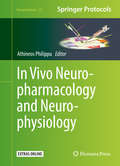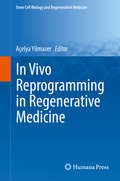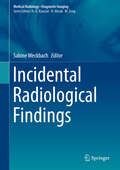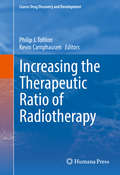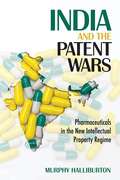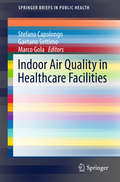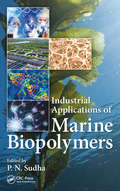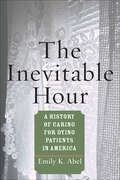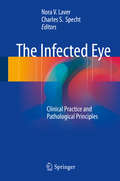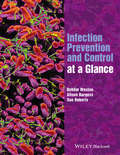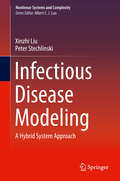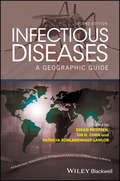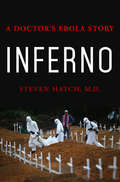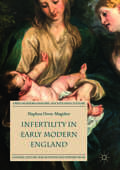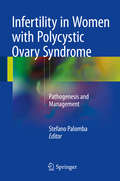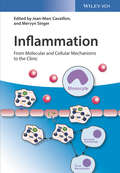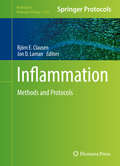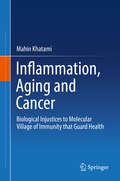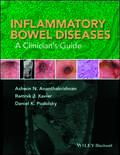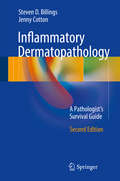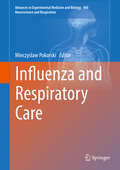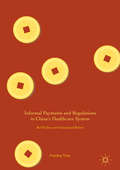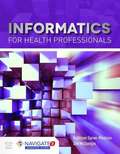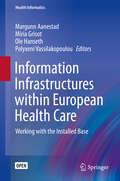- Table View
- List View
In Vivo Neuropharmacology and Neurophysiology
by Athineos PhilippuThis volume presents classical approaches to in vivo neuropharmacology and neurophysiology, such as c-fos, electrochemistry, microdialysis microstimulation, and push-up superfusion. It also explores exciting new methods for behavioral analysis, and techniques based on optogenetics and non-invasive magnetic resonance imaging. The chapters of this book cover topics such as principles of stereotaxy, pharmaco-based fMRI and neurophysiology in humans and non-human primates, electrical nerve stimulation and central microstimulation, involvement of neurotransmitters in mnemonic processes, the impact of cannabinoids on motor activity, as well as the involvement of nitric oxide in neurotoxicity produced by psychostimulant drugs. Each chapter also discusses difficulties, tips, tricks, and precautions to take. Neuromethods series style chapters include the kind of detail and key advice from the specialists needed to get successful results in your own laboratory.Cutting-edge and practical, In Vivo Neuropharmacology and Neurophysiology is a valuable resource for experienced and less experienced investigators of brain function and brain disorders.
In Vivo Reprogramming in Regenerative Medicine
by Açelya YilmazerThis new volume reviews current progress on different approaches of in vivo reprogramming technology. Leaders in the field discuss how in vivo cell lineage reprogramming can be used for tissue repair and regeneration in different organs, including brain, spinal cord, pancreas, liver and heart. Recent studies on in vivo cell reprogramming towards pluripotency are reviewed; examples are given to show its potential in regenerative medicine. In each chapter, the regenerative potential of different in vivo reprogramming approaches is discussed in detail. More specifically, how different tissue failures or damages can be treated with this technology is explained. Examples from various animal models are given and the regenerative potential of in vivo reprogramming is compared to that of cell transplantation studies. The last chapter discusses current challenges of these preclinical studies and gives suggestions in order to improve the current strategies. Future directions are indicated for the transition of in vivo reprogramming technology to clinical settings. This is among the first books in the literature which specifically focuses on the in vivo reprogramming technology in regenerative medicine and these chapters collectively cover one of the most important and exciting topics of regenerative medicine.
Incarnate: A Novel
by Josh StolbergAn ambitious and sharp-witted clinical psychiatrist turns detective when one of her patients comes under investigation for a series of brutal murders—is she a psychopath or a victim herself?Brilliant psychiatric resident Dr. Kim Patterson has one major flaw: she is too committed to her patients. Her willingness to break the rules and use unconventional methods to help her patients heal has already gotten her thrown out of several hospitals. And when Scarlett Hascall is brought into the psychiatric ward, Kim can’t resist getting involved, even if it means breaking protocol—because Kim can see what the other doctors cannot. Scarlett is suffering from a rare condition: Dissociative Identity Disorder, otherwise known as Multiple Personalities. But even Kim is at a loss when she realizes that some of Scarlett’s alternate identities are claiming to be people who have gone missing from their town. And when Scarlett’s alter identity “Izzi” knows way too much about the whereabouts of the missing Isabel Wilcox, the police begin to suspect that Scarlett may have been involved with Isabel’s disappearance. Only Kim defends Scarlett, certain of the girl’s innocence. But her new theory is a radical one, one she can hardly believe herself: What if Kim is channeling the troubled souls of these victims? With the help of local police officer Zack Trainor, Kim digs further into Isabel’s case, trying to find proof that Scarlett wasn’t involved. The more they discover, the more it becomes apparent that something strange and frightening is going on with Scarlett. Is it possible she is truly harboring lost souls? Or is Scarlett playing a twisted game with her doctors and the police?
Incidental Radiological Findings
by Sabine WeckbachThis book covers incidental radiological findings (IFs) from different perspectives, provides interesting ethical background information, highlights the differences between IFs in clinical routine and during research studies, explains the management of IFs with reference to practices in different countries, and presents information on follow-up and statistical methods. The prevalence of IFs is increasing due to the wider use of modern imaging modalities in routine clinical practice and large population-based cohort studies. The reporting of these findings may lead to further diagnostic investigations and treatment and must therefore be handled with knowledge and care. The management of IFs in clinical routine is regulated by the guidelines of the different academic societies, while management in the setting of research studies depends on a variety of factors. In general, IFs must be disclosed to the imaged subject if they are potentially clinically relevant, but subjects must also be protected from the consequences of false positive findings. This book, written by distinguished experts in their fields, discusses all these issues and will be of interest to radiologists, other clinicians, and radiographers/technicians.
Increasing the Therapeutic Ratio of Radiotherapy
by Philip J. Tofilon Kevin CamphausenCurrent cancer therapies are focused on three general strategies: modifying intrinsic radiosensitivity via molecular targeting, manipulating microenvironmental factors to enhance tumor susceptibility to radiation, and improving delivery of radiation to critical tumor locations while sparing normal tissues. The goal of this volume is to describe a number of promising approaches corresponding to each strategy. In general, research in radiation oncology tends to be siloed into fundamental biology, physics or treatment delivery. The strategies for improving therapeutic ratio encompassed in this book will involve each of these components of radiation oncology. Thus, they will illustrate the variety of disparate approaches available for potentially improving the efficacy of radiotherapy, which may then stimulate discussion across disciplines and foster further translational investigations. Although a goal of each chapter will be to highlight advances within an approach, of equal importance will be the delineation of barriers to successful clinical application and how to overcome or minimize such impediments. Along these lines, because therapeutic ratio incorporates both tumor and normal tissue radio response, a point of emphasis will be the mechanistic rationale for selectively modifying tumor (sensitization) or normal cells (protection). Finally, whereas the literature is replete with studies describing potential targets/strategies for increasing the therapeutic ratio for radiotherapy, this book will focus on those supported by in vivo data consistent with impending translational application along with those that are already being evaluated in the clinic.
India and the Patent Wars: Pharmaceuticals in the New Intellectual Property Regime (The Culture and Politics of Health Care Work)
by Murphy HalliburtonIndia and the Patent Wars contributes to an international debate over the costs of medicine and restrictions on access under stringent patent laws showing how activists and drug companies in low-income countries seize agency and exert influence over these processes. Murphy Halliburton contributes to analyses of globalization within the fields of anthropology, sociology, law, and public health by drawing on interviews and ethnographic work with pharmaceutical producers in India and the United States.India has been at the center of emerging controversies around patent rights related to pharmaceutical production and local medical knowledge. Halliburton shows that Big Pharma is not all-powerful, and that local activists and practitioners of ayurveda, India’s largest indigenous medical system, have been able to undermine the aspirations of multinational companies and the WTO. Halliburton traces how key drug prices have gone down, not up, in low-income countries under the new patent regime through partnerships between US- and India-based companies, but warns us to be aware of access to essential medicines in low- and middle-income countries going forward.
Indoor Air Quality in Healthcare Facilities
by Stefano Capolongo Gaetano Settimo Marco GolaThis interdisciplinary guide offers background, research findings, and practical strategies for assessing and improving air quality in hospitals and other healthcare settings. Positing good air quality as critical to patient and staff wellbeing, it identifies disease-carrying microbes, pollutants, and other airborne toxins and their health risks, and provides localized interventions for reducing transmission of pathogens. Effective large-scale approaches to air quality control are also outlined, from green building materials to hygienic HVAC and air treatment practices. Its thoroughness of coverage makes this book a vital resource for professionals involved in every aspect of health service facilities, from planning and construction to maintenance and management. Among the topics covered: #65533; Existing guidelines in indoor air quality: the case study of hospital environments #65533; Analysis of microorganisms in hospital environments and potential risks #65533; Legionella indoor air contamination in healthcare environments #65533; HVAC system design in healthcare facilities and control of aerosol contaminants #65533; Assessment of indoor air quality in inpatient wards Indoor Air Quality in Healthcare Facilities imparts up-to-date expertise to a variety of professional readers, including hospitals' technical and management departments, healthcare facilities' chief medical officers, hospital planners, sport and thermal building designers, public health departments, and students of universities and schools of hygiene.
Industrial Applications of Marine Biopolymers
by P. N. SudhaIndustrial Applications of Marine Biopolymers presents different classes of marine biopolymers and their industrial applications, demonstrating the precious value of ocean resources to society. This timely volume discusses the exceedingly useful polymers derived from these materials that are biodegradable, biocompatible, and at times water soluble. Direct use or chemically modified forms of such biomaterials have many chemical sites, making them suitable for varied types of industrial applications. In addition, this book also addresses current global challenges of conservation, including extended drought conditions and the need for improved agricultural methods, together with new bio-medical developments. It is suitable for anyone who has an interest in the industrial applications of biopolymers.
The Inevitable Hour: A History of Caring for Dying Patients in America
by Emily K. AbelChanges in health care have dramatically altered the experience of dying in America.At the turn of the twentieth century, medicine’s imperative to cure disease increasingly took priority over the demand to relieve pain and suffering at the end of life. Filled with heartbreaking stories, The Inevitable Hour demonstrates that professional attention and resources gradually were diverted from dying patients. Emily K. Abel challenges three myths about health care and dying in America. First, that medicine has always sought authority over death and dying; second, that medicine superseded the role of families and spirituality at the end of life; and finally, that only with the advent of the high-tech hospital did an institutional death become dehumanized. Abel shows that hospitals resisted accepting dying patients and often worked hard to move them elsewhere. Poor, terminally ill patients, for example, were shipped from Bellevue Hospital in open boats across the East River to Blackwell’s Island, where they died in hovels, mostly without medical care. Some terminal patients were not forced to leave, yet long before the advent of feeding tubes and respirators, dying in a hospital was a profoundly dehumanizing experience.With technological advances, passage of the Social Security Act, and enactment of Medicare and Medicaid, almshouses slowly disappeared and conditions for dying patients improved—though, as Abel argues, the prejudices and approaches of the past are still with us. The problems that plagued nineteenth-century almshouses can be found in many nursing homes today, where residents often receive substandard treatment. A frank portrayal of the medical care of dying people past and present, The Inevitable Hour helps to explain why a movement to restore dignity to the dying arose in the early 1970s and why its goals have been so difficult to achieve.
The Infected Eye
by Nora V. Laver Charles S. SpechtThis book discusses the diagnosis and treatment of common ocular infections with the aim of clearly explaining current recommended clinical practice in order to aid physicians involved in the care of patients. Relevant pathological principles are described to provide a basis for the understanding of these disorders. The epidemiology of infection as a class of ocular disease and the pathological effects of infectious processes in tissue are discussed in an introductory section. These fundamentals are explained and reinforced with tables and selected illustrations of tissue pathology. Leading clinical specialists then describe the diagnosis and treatment of infections of the conjunctiva, cornea, intraocular tissues, orbit, eyelids, and ocular adnexa as they present in adults and children. Illustrative tables and algorithms enhance the discussion, making key principles accessible to the busy clinician. The book contains useful appendices that summarize relevant microbiological techniques, recommendations for specimen collection and transport, and current principles for the appropriate use of antibiotics.
Infection Prevention and Control at a Glance
by Debbie Weston Sue Roberts Alison BurgessInfection Prevention and Control at a Glance isthe perfect companion for study and revision for pre-registration nursing and healthcare students, as well as qualified nurses and medical students. Infection prevention and control is one of the key five 'essential skills clusters' that is incorporated into all pre-registration nursing programmes. This highly visual and dynamic book is a thorough resource for nurses wanting to consolidate and expand their knowledge of this important part of nursing. Written by experienced infection prevention and control specialist nurses, it provides a concise and simple approach to a vast and complex subject, and equips the reader with key information in relation to various aspects of infection prevention and control practice. Provides a snap-shot of the application of infection prevention and control in practice and the key infections affecting patients in both acute and primary care A uniquely visual and accessible overview of a topic of relevance to all nursing staff Includes key points for clinical practice, patient management, and signposting of key national guidance documents and websites Available in a wide-range of digital formats - perfect for 'on the go' study and revision
Infectious Disease Modeling
by Xinzhi Liu Peter StechlinskiThis volume presents infectious diseases modeled mathematically, taking seasonality and changes in population behavior into account, using a switched and hybrid systems framework. The scope of coverage includes background on mathematical epidemiology, including classical formulations and results; a motivation for seasonal effects and changes in population behavior, an investigation into term-time forced epidemic models with switching parameters, and a detailed account of several different control strategies. The main goal is to study these models theoretically and to establish conditions under which eradication or persistence of the disease is guaranteed. In doing so, the long-term behavior of the models is determined through mathematical techniques from switched systems theory. Numerical simulations are also given to augment and illustrate the theoretical results and to help study the efficacy of the control schemes.
Infectious Diseases: A Geographic Guide
by Eskild Petersen Lin Hwei Chen Patricia Schlagenhauf-LawlorThis concise and practical guide describes infections in geographical areas and provides information on disease risk, concomitant infections (such as co-prevalence of HIV and tuberculosis) and emerging bacterial, viral and parasitic infections in a given geographical area of the world. Infectious Diseases: A Geographic Guide is divided according to United Nations world regions and addresses geographic disease profiles, presenting symptoms and incubation periods of infections. Each chapter contains a section on the coverage of the childhood vaccination programs in the countries included in that region. Chapters also include descriptions of infectious disease risk and problems with resistant bacteria in each region (e. g. antibiotic resistance in Salmonella infections in Southeast Asia). For the clinician, this book is a tool to generate differential diagnoses by considering the geographical history, as well the presenting symptoms and duration of illness. For the travel medicine specialist, this book provides information on risks of different diseases at various destinations and is particularly useful in advising long-term travelers.
Inferno: A Doctor's Ebola Story
by Steven Hatch"Hatch packs a wealth of knowledge into the book...poignant." -Associated PressDr. Steven Hatch, an infectious disease specialist, first came to Liberia in November 2013 to work at a hospital in Monrovia. Six months later, several of the physicians he had served with were dead or unable to work, and Ebola had become a world health emergency. Inferno is his account of the epidemic that nearly consumed a nation, as well as its deeper origins.Hatch returned with the aid organization International Medical Corps to help establish an Ebola Treatment Unit. Alongside a devoted staff of expats and Liberians in a hastily constructed facility nestled into the jungle, Hatch witnessed the unit's physicians, nurses, other caregivers, and patients selflessly helping others, preserving hope in the face of fear, and maintaining dignity across the divide of health and illness. And, over repeated visits during the course of the outbreak, Hatch came to understand the Ebola catastrophe not only as a contagious virus but as a product of Liberia's violent history and America's role in it.Powerful and clear-eyed, Inferno not only explores a deadly virus and an afflicted country, but also reveals how the Ebola outbreak stoked nativist anxieties that were exploited for political gain in the United States and around the world. In telling one doctor's story, Inferno demonstrates how generations of inequality left Liberia vulnerable to crisis, and how similar circumstances might fuel another plague elsewhere. By understanding and alleviating those circumstances, Hatch writes, we may help smother the fire next time.
Infertility in Early Modern England
by Daphna Oren-MagidorThis book explores the experiences of people who struggled with fertility problems in sixteenth and seventeenth-century England. Motherhood was central to early modern women's identity and was even seen as their path to salvation. To a lesser extent, fatherhood played an important role in constructing proper masculinity. When childbearing failed this was seen not only as a medical problem but as a personal emotional crisis. Infertility in Early Modern England highlights the experiences of early modern infertile couples: their desire for children, the social stigmas they faced, and the ways that social structures and religious beliefs gave meaning to infertility. It also describes the methods of treating fertility problems, from home-remedies to water cures. Offering a multi-faceted view, the book demonstrates the centrality of religion to every aspect of early modern infertility, from understanding to treatment. It also highlights the ways in which infertility unsettled the social order by placing into question the gendered categories of femininity and masculinity.
Infertility in Women with Polycystic Ovary Syndrome
by Stefano PalombaThis book presents up-to-date knowledge on infertility in the context of polycystic ovary syndrome (PCOS) and provides clear evidence-based guidance on its treatment. The book opens by discussing anovulation, oocyte quality, and the endometrium in women with PCOS, infertility and subfertility cofactors, and the impact of PCOS phenotypes on fertility. All aspects of management are then thoroughly addressed. The available medical treatments for PCOS-related infertility - including antiestrogens, aromatase inhibitors, insulin-sensitizing drugs, and gonadotropins - are reviewed, and other potential therapeutic approaches, such as acupuncture and laparoscopic ovarian drilling, are assessed. Careful attention is also devoted to the role of lifestyle interventions. The use of controlled ovarian stimulation in infertile PCOS patients undergoing intrauterine insemination or in vitro fertilization is examined in detail, as are the benefits of in vitro maturation of oocytes. This book will be of value to all who are involved in the care of women with PCOS and related infertility issues.
Inflammation: From Molecular and Cellular Mechanisms to the Clinic
by Jean-Marc Cavaillon Mervyn SingerThe leading reference on this topic of increasing medical relevance is unique in offering unparalleled coverage. The editors are among the most respected researchers in inflammation worldwide and here have put together a prestigious team of contributors. Starting with the molecular basis of inflammation, from cytokines via the innate immune system to the different kinds of inflammatory cells, they continue with the function of inflammation in infectious disease before devoting a large section to the relationship between inflammation and chronic diseases. The book concludes with wound and tissue healing and options for therapeutic interventions. A must have for clinicians and biomedical researchers alike.
Inflammation
by Björn E. Clausen Jon D. LamanThis volume presents a broad selection of cutting-edge methods and tools that will enable the reader to investigate the multi-faceted manifestations of inflammation. Inflammation: Methods and Protocols is divided into four sections: the first three sections describe protocols investigating immune-mediated inflammatory disease models affecting barrier organs to the environment; the skin, the lung, and the intestinal and oral mucosa. The fourth section illustrates inflammatory disease models of the brain, joints, and vasculature. Written in the highly successful Methods in Molecular Biology series format, chapters include introductions to their respective topics, lists of the necessary materials and reagents, step-by-step, readily reproducible laboratory protocols, and notes on troubleshooting and avoiding known pitfalls. Authoritative and practical, Inflammation: Methods and Protocols aims to inspire the experienced investigator and the young experimenter alike to disentangle the fascinating process of inflammation.
Inflammation, Aging and Cancer
by Mahin KhatamiThis book was prepared as extension of author's accidental discoveries on experimental models of acute and chronic ocular inflammatory diseases that were established at the University of Pennsylvania in 1980's. Analyses of original data suggest a series of first evidence for direct link between inflammation and developmental phases of immune dysfunction in multistep tumorigenesis and angiogenesis. The only evidence presented on initial events for interactions and synergies between activated host and recruiting cells toward tumorigenesis. Effective immunity was defined as balance between two highly regulated and biologically opposing arms, Yin and Yang of acute inflammation, an amazingly precise signal communications between immune and non-immune systems requiring differential bioenergetics. Unresolved inflammation is a common denominator mapping aging process and induction of 'mild', 'moderate' or 'severe' immune disorders including cancers. Our knowledge of the fascinating biology of immunity in health or chronic diseases is fragmentary, chaotic and confusing, particularly for cancer science. Lack of progress in curing majority of chronic diseases or cancer is primarily due to the fact that scientists work on isolated molecules/cells or topics that are funded and promoted by decision makers in medical/cancer establishment. Despite existence of over 25 million articles on cancer-related topics, cancer biology and cure remain mysteries to be solved. After a century of cancer research, the failure rates of therapies for solid tumors are 90% (+/-5). Current reductionist views on cancer science are irresponsible, shut-gun approaches and create chaos. Outcomes are loss of millions of precious lives and economic drain to society. Very little is known about initial events that disturb effective immunity whose function is to monitor and arrest growth of cancerous cells or defend against other external or internal hazardous agents that threaten body's survival. The author demonstrates the serious need for systematic understanding of how immune disruptors and aging process would alter effective immunity. Outcomes of proposed orderly studies are expected to provide logical foundations for cost-effective strategies to promote immunity toward a healthier society. The policy makers and medical/cancer establishment are urged to return to the common sense that our Forefathers used to serve the public.
Inflammatory Bowel Diseases: A Clinician's Guide
by Ashwin N. Ananthakrishnan Daniel K. Podolsky Ramnik J. XavierInflammatory Bowel Diseases: A Clinician’s Guide provides practical guidance for the diagnosis and management of those suspected or known to have one of the forms of these complex diseases. It is perfect both for gastroenterology trainees learning to care for these patients and the experienced physician as a concise and practical resource for day to day use. Written by the experts, Inflammatory Bowel Diseases: A Clinician’s Guide is an essential tool for all gastroenterologists managing patients with inflammatory bowel disease.
Inflammatory Dermatopathology
by Steven D. Billings Jenny CottonThis fully updated and revised new edition will guide the reader to develop a systematic approach to the diagnosis of inflammatory disorders of the skin. It covers the most common and clinically important inflammatory disorders of the skin in a image-rich easy to read format. Each section includes a practical tips section to help navigate the differential diagnosis. Examples of diagnostic comments are provided that practicing pathologists can utilize in their own reports. Therefore, this book will not only guide the reader in how to approach inflammatory dermatoses, it will also help with writing the report. All chapters are revised and updated and include new images. The second edition of Inflammatory Dermatopathology will be of great value to surgical pathologists, pathology residents, dermatology residents, and dermatopathology fellows.
Influenza and Respiratory Care
by Mieczyslaw PokorskiRespiratory infections constitute a major public health concern. The goal of this book is to share knowledge on the best advances in influenza and influenza-like viral infections, and new molecular-based diagnostic methods that discern the antigenic shift providing viruses the ability to constantly evolve and elude the host immune response. Co-infections, co-morbidities, persistently meager anti-flu vaccination coverage, and infection complications are dealt with. The chapters also further insight into such topics as the effect of sex hormones, and socioeconomic and anthropometric measures, on respiratory and immune functions underlying the severity of asthma and respiratory allergy. Psychological functioning in respiratory disorders, taking into account quality of life, illness acceptance, and depressive symptoms is also reviewed as it is all too often underestimated by healthcare providers. The book is intended for clinicians, researchers, students, and all other actors in health-related issues.
Informal Payments and Regulations in China's Healthcare System
by Jingqing YangThis text addresses the key issue of informal payments, or 'red packets', in the Chinese Healthcare system. It considers how transactions take place at the clinical level as well as their regulation. Analysing the practice from the perspectives of institutions and power structure, it examines how institutional changes in the pre-reform and reform era have changed the power structure between medical professions, patients and the Party-state, and how these changes have given rise and perpetuate the practice. Drawing from qualitative data from interviews of medical professionals, the author recognises the medical profession as a major player in the health care system and presents their perception of the practice as the taker of 'red packets' and their interactions with the patient and the state surrounding the illegal practice in an authoritarian power structure. The books considers the institutional reasons that motivate doctors to take, patients to give, and the government to "tolerate" red packets, arguing that the bureaucratization of the medical profession, society of acquaintances and shortage of quality of medical services jointly create an institutional setting that has given rise to these informal payments. Contributing to a rounded understanding of the problems of healthcare reform in China, this book is a key read for all scholars interested in the issue of informal payments and healthcare politics in transition economies.
Informatics for Health Professionals (Navigate 2 Advantage Access)
by Kathleen Mastrian Dee McGonigleNew edition available December 2019! Informatics for Health Professionals is an excellent resource to provide healthcare students and professionals with the foundational knowledge to integrate informatics principles into practice. <P><P>The theoretical underpinning of this text is the Foundation of Knowledge model, which explains how informatics relates to knowledge acquisition, knowledge processing, knowledge generation, knowledge dissemination, and feedback. Once readers understand informatics and the way in which it supports practice, education, administration, and research, they can apply these principles to improve patient care at all levels.
Information Infrastructures within European Health Care
by Margunn Aanestad Miria Grisot Ole Hanseth Polyxeni VassilakopoulouThis book is open access under a CC BY-NC 2. 5 license. The book aims to be a resource for those interested in planning and implementing large-scale information infrastructures for novel electronic services in health care. The focus of this book is on the pivotal role of the installed base (i. e. the already existing elements of an infrastructure) for ensuing infrastructural development. The book presents rich empirical cases on the design, development and implementation of core infrastructural components (e-prescription and public patient-oriented web platforms) in different national settings across Europe. Therefore, this is a book in which theoretical insights and practical experiences are tightly connected. Contributions have been sourced from a network of academics that have been working on the topic for years, and who have previously collaborated and shared a common understanding of the challenges entailed in expanding information infrastructures within healthcare. The book aims to become a reference for those seeking theoretical and empirical insights for conceptualizing and steering the evolution of information infrastructures in healthcare. The two types of systems (e-prescription and public patient-oriented web platforms) have been selected because they are widespread across Europe, because they invite comparisons, and because they are exemplary of two different types of aims. E-prescription initiatives are usually seen as opportunities to improve healthcare delivery by systematic and not dramatic change. Public patient-oriented web platforms are seen as opportunities to pursue wider and more radical innovation. This book targets researchers, practitioners and students who would benefit from a book providing a comprehensive view to contemporary approaches for the design and deployment of large-scale, inter-organizational systems within healthcare. This book is open access under a CC BY 4. 0 license.
